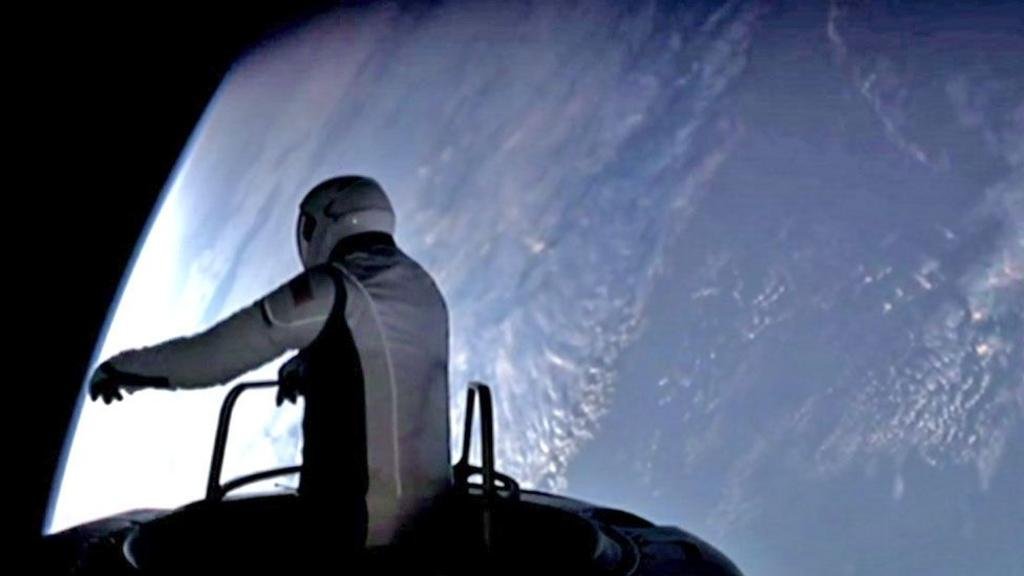Historic Spacewalk by Non-Professional Crew
A billionaire and an engineer have made history by becoming the first non-professional duo to successfully complete one of space’s most dangerous tasks—a spacewalk. Jared Isaacman and Sarah Gillis stepped out of the SpaceX spacecraft, 15 minutes apart, starting at 11:52 BST, both suited up in custom-made gear for the mission.
Back home, there’s always plenty of work to do, but from up here, Earth really does seem like a perfect place,” Mr. Isaacman remarked as he stepped out.
Innovative Spacecraft Design and Technology
The mission was entirely funded by Mr. Isaacman. Until now, only astronauts from government-backed space agencies had ever completed a spacewalk. Live video captured the moment both crew members emerged from the white Dragon capsule, hovering 435 miles (700 km) above Earth. Mr. Isaacman was the first to exit, moving his arms, hands, and feet to check his suit. Once he returned to the hatch, Ms. Gillis, a SpaceX employee, followed and made her way out next. Both crew narrated their spacewalk, describing how their suits performed outside of the craft.
The spacewalk, in the beginning scheduled for 07:23 BST, become postponed on Thursday morning. As the team organized to open the hatch on a spacecraft without an airlock, their excitement and anxiety grew. With no doorway separating the vacuum of space from the spacecraft, they needed to be extremely careful. The four crew members had spent two days “pre-breathing” to prevent decompression sickness, or “the bends,” which occurs from rapid pressure changes. This preparation involved replacing nitrogen in their blood with oxygen to avoid severe health issues.
The spacecraft was then depressurized to better simulate space conditions. Dr. Simeon Barber, a research scientist at the Open University, highlighted that this spacewalk used a “very different approach” compared to previous walks performed from places like the International Space Station.
Pre-Mission Preparations and Challenges
In recent decades, astronauts have typically used an airlock to separate the spacecraft from the vacuum of space. However, the SpaceX Dragon capsule was essentially open to space. “It’s really exciting and demonstrates that SpaceX isn’t afraid to explore new methods,” Dr. Barber told BBC News. Despite the innovation, the mission had considerable risks. Mr. Isaacman, who funded the Polaris Dawn mission, was the only one of the four crew members with prior space experience.
He is the commander of the Resilience spacecraft, accompanied by his close friend Scott ‘Kidd’ Poteet, a retired Air Force pilot, and two SpaceX engineers, Anna Menon and Sarah Gillis. The Dragon capsule used by the team had previously launched into space 46 times, carrying a total of 50 crew members. However, neither the capsule nor the spacesuits were subject to regulation and had not been tested in this particular environment.
Significance of the Spacewalk in Space Travel History
Spacewalks are among the most challenging maneuvers in space, so completing one successfully by a private company is a major milestone in space travel history. This spacewalk, conducted at an altitude of 435 miles (700 km), was higher than any previous walk and used advanced technology in the new extravehicular activity (EVA) astronaut suits. These EVA suits are an upgrade from SpaceX’s earlier intra vehicular activity (IVA) suits and include a heads-up display in the helmet, offering real-time information about the suit’s status during use.
While outside the Dragon capsule, Sarah Gillis used her heads-up display to read data. SpaceX claims that the EVA suits are designed to be comfortable and flexible enough for use during both launch and landing, eliminating the need for separate IVA suits. Extra nitrogen and oxygen tanks were included, and all four astronauts wore these suits, setting a new record for the most people simultaneously in the vacuum of space.
Future of Private Space Travel
The Resilience spacecraft launched from Earth on Tuesday aboard a SpaceX rocket. The task ambitions to reach up to 870 miles (1,400 km) in orbit—similarly than any human has traveled in space since the stop of NASA’s Apollo application within the 1970
Government space businesses like NASA are exploring partnerships with the personal zone to move astronauts and reduce the charges of space tour. Entrepreneurs like Isaacman and Elon Musk are working to extend non-public area travel, aiming to make it viable for extra non-expert astronauts to project into space. Although this marks an crucial symbolic boost, making space travel more accessible to the general public is in all likelihood nonetheless a protracted manner off due to the high expenses worried.
For Further Details, Stay Tuned With Us!
